This month sees the following articles in Analyst that are in the top ten most accessed:-
Gold nanoparticles-based nanoconjugates for enhanced enzyme cascade and glucose sensing
Dongdong Zeng , Weijie Luo , Jiang Li , Huajie Liu , Hongwei Ma , Qing Huang and Chunhai Fan
Analyst, 2012,137, 4435-4439 DOI: 10.1039/C2AN35900F
A BODIPY derivative as a highly selective “Off–On” fluorescent chemosensor for hydrogen sulfate anion
Qian Li , Yong Guo and Shijun Shao
Analyst, 2012,137, 4497-4501 DOI: 10.1039/C2AN35904A
A turn-on and reversible fluorescence sensor for zinc ion
Hsiang-Yi Lin , Pi-Yun Cheng , Chin-Feng Wan and An-Tai Wu
Analyst, 2012,137, 4415-4417 DOI: 10.1039/C2AN35752F
Upconversion nanoparticles in biological labeling, imaging, and therapy
Feng Wang , Debapriya Banerjee , Yongsheng Liu , Xueyuan Chen and Xiaogang Liu
Analyst, 2010,135, 1839-1854 DOI: 10.1039/C0AN00144A
Development of a pH-activatable fluorescent probe and its application for visualizing cellular pH change
Rong Huang , Shengyong Yan , Xiaolong Zheng , Fengling Luo , Minggang Deng , Boshi Fu , Yijie Xiao , Xi Zhao and Xiang Zhou
Analyst, 2012,137, 4418-4420 DOI: 10.1039/C2AN35671F
A simple colorimetric device for rapid detection of Hg2+ in water
Tingxiu Ye , Chunyan He , Yanqin Qu , Zhuo Deng , Yaqi Jiang , Meijin Li and Xi Chen
Analyst, 2012,137, 4131-4134 DOI: 10.1039/C2AN35422E
BSA-templated MnO2 nanoparticles as both peroxidase and oxidase mimics
Xing Liu , Qi Wang , Huihui Zhao , Lichun Zhang , Yingying Su and Yi Lv
Analyst, 2012,137, 4552-4558 DOI: 10.1039/C2AN35700C
CTAB-capped Mn-doped ZnS quantum dots and label-free aptamer for room-temperature phosphorescence detection of mercury ions
Wan Yi Xie , Wei Tao Huang , Hong Qun Luo and Nian Bing Li
Analyst, 2012,137, 4651-4653 DOI: 10.1039/C2AN35777A
Functionalized shell-isolated nanoparticle-enhanced Raman spectroscopy for selective detection of trinitrotoluene
Kai Qian , Honglin Liu , Liangbao Yang and Jinhuai Liu
Analyst, 2012,137, 4644-4646 DOI: 10.1039/C2AN35947B
Electrochemical analysis based on nanoporous structures
Sangyun Park , Hee Chan Kim and Taek Dong Chung
Analyst, 2012,137, 3891-3903 DOI: 10.1039/C2AN35294J
Why not take a look at the articles today and blog your thoughts and comments below.
Fancy submitting an article to Analyst? Then why not submit to us today or alternatively email us your suggestions.
Comments Off on Top ten most accessed articles in August











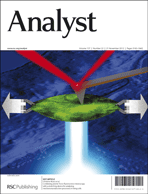

 Take a look below at some wonderful HOT articles we’ve recently published this month in Analyst. There are papers covering a large variety of fields, including metabolomics, sample preparation, fluorimetry and electrochemiluminescent sensing. These HOT papers will be free to read for two weeks.
Take a look below at some wonderful HOT articles we’ve recently published this month in Analyst. There are papers covering a large variety of fields, including metabolomics, sample preparation, fluorimetry and electrochemiluminescent sensing. These HOT papers will be free to read for two weeks.




